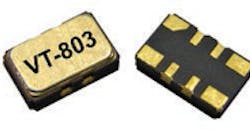Many modern communications applications call for a reference source with low phase noise. At the same time, the oscillator must be small enough to fit the requirements of such products as manpack military radios and femto cells for commercial wireless communications. Fortunately, the VT-803 temperature-compensated crystal oscillator (TCXO) from Vectron International keeps the noise to a minimum, and does so in a small, hermetic surface-mount-technology (SMT) ceramic package measuring just 5.0 x 3.2 mm. Available with clipped sinewave or CMOS output frequencies from 10 to 52 MHz, the TCXO is able to achieve low phase noise of -159 dBc/Hz offset 1 MHz from the carrier, with outstanding frequency stability over temperatures from -40 to +85C.
In spite of the small size, the VT-803 TCXO (see figure) manages to pack analog temperature compensation within the SMT housing for outstanding frequency stability with temperature. With clipped sine-wave outputs, the VT-803 can be specified for one of five grades of frequency stability: 100, 200, 280, or 500 ppb, or 1 ppm. It can also be ordered with a variety of operating temperature ranges: -10 to +70C, -20 to +70C, -30 to +85C, or -40 to +85C. In addition, a range of supply voltages are available: +2.8, +3.0, +3.3, or +5.0 VDC. The initial frequency accuracy of a supplied VT-803 is ±1.1 ppm. The aging rate is a worst case of 0.5 ppm/year.
The oscillator maintains its stability even with changes in power supply and load conditions. By way of example, the worst-case frequency stability holds within a 0.05 ppm tolerance for a 5% change in power supply. Similarly, the worst-case frequency stability is within 0.05 ppm for a ±10% change in load.
For a VT-803 with clipped sine-wave outputs measured with a 26-MHz signal, the single-sideband (SSB) phase noise is typically -91 dBc/Hz offset 10 Hz from the carrier. The phase noise improves to -117 dBc/Hz offset 100 Hz from the carrier, -136 dBc/Hz offset 1 kHz from the carrier, and -150 dBc/Hz offset 10 kHz from the carrier. It levels off at -158 dBc/Hz offset 100 kHz from the carrier and beyond.
A VT-803 with CMOS outputs is available over the same operating temperature ranges and with the same aging rate. The choices in frequency stability are 0.5, 1.0, or 2.0 ppm. The frequency stability holds within a worst case of 0.05 ppm for a 5% change in power supply or a 10% change in load conditions. The phase noise for a CMOS VT-803 (also for a 26-MHz carrier) is typically -91 dBc/Hz offset 10 Hz from the carrier, -117 dBc/Hz offset 100 Hz from the carrier, -139 dBc/Hz offset 1 kHz from the carrier, -153 dBc/Hz offset 10 kHz from the carrier, and -157 dBc/Hz offset 100 kHz from the carrier and beyond. The CMOS source exhibits 2.5 ps root-mean-square (RMS) jitter and 21 ps peak jitter.
The VT-803 TCXO is a fundamental-frequency crystal oscillator design that is RoHS compliant and fully compatible with lead-free assembly techniques. It features gold over nickel contact pads and an enable/disable function to control the output. As an option, it can be supplied as a voltage-controlled crystal oscillator (VCXO) when some frequency tuning is required. "Our new VT-803 allows designers to continue on the path of integration, while offering high stability low phase noise and low aging in a 5 mm x 3.2 mm footprint," says Alan Mond, Vice President and General Manager of Vectron's Communication Business Unit. "The ability to offer 100 ppb in a 5 mm x 3.2 mm footprint gives the designers of small footprint platforms new levels of stabilities they previously did not have access to."
Vectron International
267 Lowell Road
Hudson, NH 03051
1-888-VECTRON-1
FAX: 1-888-FAX-VECTRON
e-mail: [email protected]

